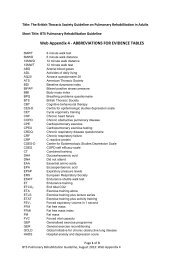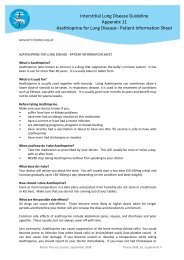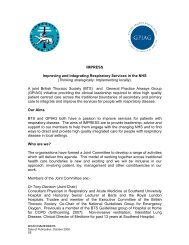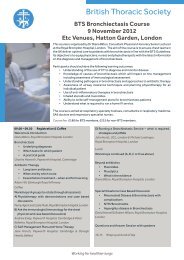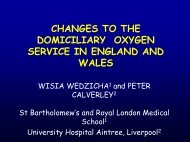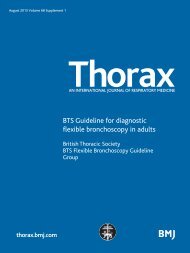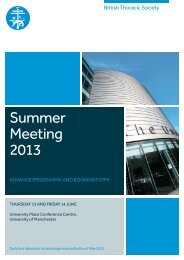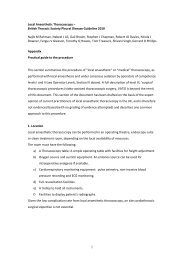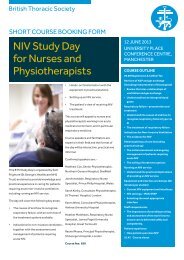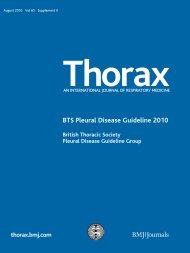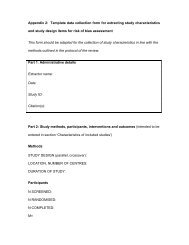Guidelines for the management of community ... - Brit Thoracic
Guidelines for the management of community ... - Brit Thoracic
Guidelines for the management of community ... - Brit Thoracic
Create successful ePaper yourself
Turn your PDF publications into a flip-book with our unique Google optimized e-Paper software.
BTS guidelines<br />
and radiographic in<strong>for</strong>mation is rarely predictive <strong>of</strong> <strong>the</strong> microbial<br />
aetiology. An important principle is that pathogens responsible<br />
<strong>for</strong> CAP are diverse and vary in <strong>the</strong>ir ability to cause severe<br />
disease. 243 [Ib] The highest mortality rates are associated with<br />
pneumococcal infection and with Legionnaires’ disease.<br />
Severity assessment and <strong>the</strong> association <strong>of</strong> pre-existing<br />
comorbid disease is essential in predicting prognosis and, in<br />
turn, determines <strong>management</strong>, choice <strong>of</strong> antibiotic <strong>the</strong>rapy and<br />
its method <strong>of</strong> administration (see Section 6).<br />
8.2 Antibiotic stewardship and <strong>the</strong> individual clinician’s<br />
responsibility to prevent <strong>the</strong> overuse <strong>of</strong> antibiotics when<br />
managing CAP<br />
The choice <strong>of</strong> antibiotic regimen has consequences beyond <strong>the</strong><br />
<strong>management</strong> <strong>of</strong> <strong>the</strong> individual patient. The inappropriate<br />
application <strong>of</strong> CAP guidelines to <strong>community</strong> acquired lower<br />
respiratory tract infections o<strong>the</strong>r than pneumonia and hospital<br />
acquired pneumonia leads, in turn, to inappropriate and<br />
potentially excessive antibiotic use. Too loose an interpretation<br />
<strong>of</strong> ‘‘severe pneumonia’’ also contributes to <strong>the</strong> overprescribing<br />
<strong>of</strong> macrolides and b-lactams, especially when administered<br />
parenterally, in <strong>the</strong> <strong>management</strong> <strong>of</strong> hospitalised patients with<br />
CAP.<br />
Overuse <strong>of</strong> antibiotics in CAP increases <strong>the</strong> cost <strong>of</strong> <strong>management</strong><br />
and, particularly in relation to quinolones and cephalosporins,<br />
serves as a driver <strong>for</strong> health care-associated infections,<br />
18 336–342 [Ib] [II] [IVa] [II] [II] [Ib]<br />
including MRSA and C difficile infection.<br />
[Ia] [Ib]<br />
The avoidance <strong>of</strong> inappropriate or excessive use <strong>of</strong><br />
antibiotics is specifically discussed in Section 8.18. Proper<br />
patient selection <strong>for</strong> treatment and <strong>the</strong> correct use <strong>of</strong><br />
antimicrobial agents are emphasised in this document.<br />
In particular, <strong>the</strong>se guidelines stress that <strong>the</strong> use <strong>of</strong> empirical<br />
broad-spectrum antibiotics is initially recommended only in<br />
patients with high severity CAP. This group <strong>of</strong> patients<br />
comprise approximately one-third <strong>of</strong> all patients admitted to<br />
hospital with confirmed CAP. Regular review and <strong>the</strong> prompt<br />
‘‘de-escalation’’ to narrow-spectrum antibiotics based on early<br />
microbiological investigations are also emphasised.<br />
8.3 Antibiotic resistance <strong>of</strong> respiratory pathogens<br />
The rate <strong>of</strong> increase in resistance among respiratory pathogens<br />
has tended to level <strong>of</strong>f in recent years.<br />
Antibiotic resistance among S pneumoniae is <strong>the</strong> main concern<br />
owing to <strong>the</strong> dominance <strong>of</strong> this organism as a cause <strong>of</strong> CAP and<br />
because penicillin and macrolide resistance are frequently<br />
linked. 343 344 [II] [II] Resistance among pneumococci is <strong>the</strong> result<br />
<strong>of</strong> alterations in one or more <strong>of</strong> <strong>the</strong> penicillin-binding proteins,<br />
thus reducing <strong>the</strong>ir affinity <strong>for</strong> penicillin. This in turn leads to a<br />
requirement <strong>for</strong> higher drug concentrations to bring about death<br />
<strong>of</strong> <strong>the</strong> organism. Of <strong>the</strong> .90 known pneumococcal serotypes, a<br />
small number have been responsible <strong>for</strong> penicillin resistance<br />
worldwide, among which selected clones (eg, 23F, 9V and 6B)<br />
have become widely disseminated. However, despite <strong>the</strong>se<br />
concerns, <strong>the</strong> clinical importance <strong>of</strong> in vitro penicillin resistance<br />
among S pneumoniae remains uncertain when treating pneumococcal<br />
pneumonia. 345–350 [II] [II] [IVb] [IVa] [II] [II] This is reflected in <strong>the</strong><br />
continued ability <strong>of</strong> current doses <strong>of</strong> penicillins to inhibit strains<br />
<strong>of</strong> intermediate susceptibility (minimum inhibitory concentration<br />
(MIC) <strong>of</strong> penicillin 0.1–1.0 mg/l), as well as many strains<br />
exhibiting higher level resistance (as defined by an MIC .1 mg/l).<br />
The <strong>Brit</strong>ish Society <strong>of</strong> Antimicrobial Chemop<strong>the</strong>rapy (BSAC)<br />
surveillance project has reported on pneumococcal susceptibility<br />
to various antimicrobials from both blood and respiratory tract<br />
Thorax 2009;64(Suppl III):iii1–iii55. doi:10.1136/thx.2009.121434<br />
samples in <strong>the</strong> UK and Ireland 1999/2000 to 2006/7. They report<br />
no convincing evidence <strong>of</strong> an increase in non-susceptibility over<br />
time, 94% <strong>of</strong> bacteraemia isolates and 92% <strong>of</strong> respiratory isolate<br />
being fully susceptible to penicillin and 85% and 88% <strong>of</strong> blood and<br />
respiratory isolates, respectively, susceptible to erythromycin and,<br />
by implication, o<strong>the</strong>r macrolides. 351 [II] With regard to erythromycin,<br />
resistance is <strong>the</strong> result <strong>of</strong> genetic mutations that ei<strong>the</strong>r affect<br />
<strong>the</strong>targetsite(erm gene mutations) or result in elimination <strong>of</strong> <strong>the</strong><br />
drug by an efflux pump (mef gene mutation). The distribution <strong>of</strong><br />
such strains differs internationally and probably explains variation<br />
in <strong>the</strong> clinical impact <strong>of</strong> such resistance, since erm gene<br />
mutations are linked to high level resistance. Tetracyclines are not<br />
widely used in <strong>the</strong> treatment <strong>of</strong> CAP and resistance among S<br />
pneumoniae is relatively low. Likewise, reduced susceptibility <strong>of</strong> S<br />
pneumoniae to fluoroquinolones is beginning to be reported, but<br />
generally remains low in <strong>the</strong> UK. 352 [II] Recent trends in penicillin,<br />
erythromycin and tetracycline resistance <strong>of</strong> around 4000–5000 S<br />
pneumoniae isolated from blood and cerebrospinal fluid cultures<br />
each year in England and Wales and reported routinely to <strong>the</strong><br />
Health Protection Agency (HPA) are shown in fig 9 (HPA<br />
unpublished data).<br />
Beta-lactamase production among H influenzae varies geographically<br />
but ranges from 2% to 17% in various parts <strong>of</strong> <strong>the</strong><br />
UK. 344 353 [II] [II] Data from <strong>the</strong> BSAC surveillance programme in<br />
<strong>the</strong> UK and Ireland 1999/2000 to 2006/7 suggest that b-<br />
lactamase production in H influenzae has been relatively stable<br />
at around 15% over <strong>the</strong> study period. 354 [II] However, this is an<br />
uncommon cause <strong>of</strong> pneumonia and, unless local data suggest<br />
o<strong>the</strong>rwise, <strong>the</strong>re is insufficient justification to include a b-<br />
lactamase resistant antibiotic regimen in initial empirical<br />
<strong>the</strong>rapy <strong>of</strong> low or moderate severity CAP. M catarrhalis is an<br />
even rarer cause <strong>of</strong> CAP, <strong>for</strong> which <strong>the</strong> same argument applies.<br />
S aureus is widely resistant to penicillin, 355 [II] and an<br />
increasing number are now methicillin-resistant (MRSA).<br />
When occurring in <strong>the</strong> <strong>community</strong> within <strong>the</strong> UK, this<br />
generally reflects hospitalisation within <strong>the</strong> recent past or<br />
residence within a nursing home. Hence, b-lactamase unstable<br />
penicillins (penicillin G, aminopenicillins) and, in <strong>the</strong> case <strong>of</strong><br />
MRSA, isoxazolyl penicillins (flucloxacillin, cloxacillin) and<br />
cephalosporins are inappropriate <strong>for</strong> such infections.<br />
L pneumophila and Legionella spp in general remain susceptible<br />
to fluoroquinolones, macrolides and rifampicin, although in<br />
vitro low level resistance has been found in some isolates.<br />
However, <strong>the</strong> clinical significance <strong>of</strong> <strong>the</strong>se observations remains<br />
unclear. 356<br />
8.4 Newer antibiotics<br />
Since <strong>the</strong> 2001 guidelines were published, moxifloxacin has been<br />
licensed in <strong>the</strong> UK <strong>for</strong> <strong>the</strong> treatment <strong>of</strong> ‘‘non-severe CAP’’. It is<br />
not licensed at this time <strong>for</strong> ‘‘severe CAP’’, nor is an intravenous<br />
preparation available in <strong>the</strong> UK; hence, we have not assessed<br />
studies which have used intravenous moxifloxacin.<br />
There are reported microbiological, pharmacokinetic and<br />
pharmacodynamic advantages <strong>for</strong> moxifloxacin compared with<br />
lev<strong>of</strong>loxacin. 357 358 [II] Clinical studies have generally shown<br />
equivalence with o<strong>the</strong>r oral antibiotics used <strong>for</strong> CAP. 359–361 [Ib]<br />
[Ib] [Ib]<br />
One showed similar outcomes but fewer side effects when<br />
compared with oral amoxycillin (1 g tds) and/or clarithromycin.<br />
362 [Ib] However, mainly in view <strong>of</strong> <strong>the</strong> increased risk <strong>of</strong><br />
adverse hepatic reactions associated with moxifloxacin, <strong>the</strong><br />
European Medicines Agency recommended in July 2008 that<br />
moxifloxacin should only be given in CAP when treatment with<br />
o<strong>the</strong>r antibiotics cannot be used. Similar advice is given in <strong>the</strong><br />
<strong>Brit</strong>ish National Formulary (http://www.bnf.org/bnf/). 363<br />
iii33



